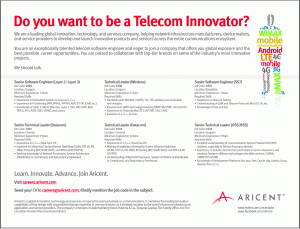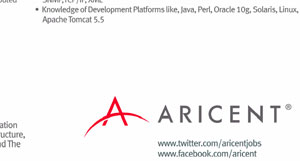It has become a weekly affair to refer to The Times of India’s recruitment supplement, Ascent, in this blog. If last week was about a Sasken recruitment ad., this week is about Aricent.
I have written earlier about brands using a Facebook URL in their advertising (Basics Lifeâ??s print ad with a Facebook community URL; Mantri Square mall wants us to search for its Twitter and Facebook pages; The Facebook URL: A misguided trend and a paradox; Website URL? Check. Facebook URL? Check. Twitter? Check. Why bother? and We look forward to hearing from you! Really?), but I don’t think I have ever seen a brand use a Facebook URL and a Twitter ID in their recruitment ad!
 Today’s Aricent ad. in Ascent has both!
Today’s Aricent ad. in Ascent has both!
The careers page URL is intact too, but these two social property URLs get prime billing, right below the Aricent logo, on the bottom right!
Obvious next step? To see what they have in store in both these social properties!
Facebook
Don’t even expect me to talk about the number of ‘likes’ – it is mighty pointless. The landing tab is impressively built, with well assembled modules for case studies and examples of thought leadership. The kind of case studies chosen seems intelligent – on topics like social networking, music management, on-demand video search and so on.
Where I seem to have a potential issue is in the wall!
It’s almost a mirror-image of what Aricent would have in it’s corporate website’s press/media section. Just because they are seen in a ‘social networking’ site like Facebook, do press releases become social? I don’t think so.
I do understand that the task is the same – the set of links should impress and give an idea about how good/innovative/amazing Aricent is and these press release’ish links in the wall do the job as well as the press section. Also, in a website URL, people (techies/ people who may be looking for employment opportunities in companies like Aricent) may not naturally go to the press section first – the people/HR section may be the first page they may head to. That is taken care of, by adding the press links in the wall, but even then, it is nothing but a press section under a alleged social garb.
Twitter
It is called @aricentjobs and this one fares much better. The tweets include a mix of specific openings and broader thoughts like contests, links to careers-related articles where Aricent is NOT mentioned (I’m impressed!!) and so on.
Beyond these two properties, here’s a larger observation.
If you’re looking at the print ad. of a new car, what would you want, as a next step? I would want,
- Some additional information, beyond the ad. hype
- Some contact where I could help myself with specific doubts and questions
- What do others think about this car?
- Basic details – price in my city, average mileage etc.
- Professional reviews
It’d be great if the ad. helps me with these points. As a digression, the Skoda Yeti ad. gives me all this through the website URL they have – it includes professional reviews, all the basic details and also Facebook and Twitter IDs for me to know what people think about the vehicle. Possibly.
Now, as a job seeker, what would you want to know about an employer who has a print advertisement? Mine would probably be the following.
- Is it worth investing my career in this company?
- Do I know someone in the company, or does someone I know knows someone in the company…for me to get a first-hand perspective about the organization?
- How is the company perceived, among my peers?
- How big is the company – people-wise and revenue-wise?
- What has the company done impressively, in recent times? Any media sighting of this company?
If you notice, the buttons pushed inside me are almost the same – whether it’s a car or a recruitment ad. So, a car’s additional information is to know whether it’s worth investing in it; contact information to get more details, at a personal level is same across both ads; peer reviews and basic details are similar across both and professional reviews (in the media!) for a car is equivalent to what media writes about the company.
With regard to the recruitment ad. #1, #4 and #5 can be addressed by the corporate website (sections on ‘about us’, ‘careers’/’people’ and ‘media’). It is #2 and #3 that are new and I suppose Aricent is trying to address these through the Facebook and Twitter URLs. The difference is of course that those allegedly-social (it is all about the way we use them!) properties don’t really help in addressing #2 and #3, which I believe is far more critical – because it is not about controlled information as in #1, #4 and #5, but genuine and actual opinions from people, which, naturally, is more trusted, depending on how well you know those connections.
 Instead, I’m just wondering aloud, would adding a LinkedIn URL (Disclosure: LinkedIn is a client of Edelman India) of the company help better? I do understand that companies may be paranoid about poaching and are usually very guarded about its employees, but these days, almost everyone who matters (or thinks he/she matters) has a LinkedIn profile. Adding a LinkedIn URL of the company could perhaps help me see 1st, 2nd or 3rd degree contacts within my network who may be in Aricent. And, I could use one or more of my connections to get a personal feel of what Aricent is like, to work in. #2 and #3 addressed!
Instead, I’m just wondering aloud, would adding a LinkedIn URL (Disclosure: LinkedIn is a client of Edelman India) of the company help better? I do understand that companies may be paranoid about poaching and are usually very guarded about its employees, but these days, almost everyone who matters (or thinks he/she matters) has a LinkedIn profile. Adding a LinkedIn URL of the company could perhaps help me see 1st, 2nd or 3rd degree contacts within my network who may be in Aricent. And, I could use one or more of my connections to get a personal feel of what Aricent is like, to work in. #2 and #3 addressed!
Aricent may have assumed that a Facebook page link may do that trick, but I’m not so sure about reaching out to an unknown Aricent employee via Facebook. For all you know, that employee may not even have listed Aricent in his profile (while finding it perfectly alright to list Russel Crowe as his favorite actor) since Facebook is still considered personal and not so professional.
But, full marks to Aricent for trying! Good effort and my observations are merely a guideline in getting it better and being more useful/appropriate within a recruitment ad’s context.
